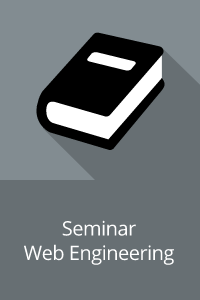
Seminar Web Engineering (SS 2019)
Welcome to the homepage of the Seminar Web Engineering
This website contains all important information about the seminar, including links to available topics as well as information about the seminar process in general.
The interdisciplinary research area Web Engineering develops approaches for the methodological construction of Web-based applications and distributed systems as well as their continuous development (evolution). For instance, Web Engineering deals with the development of interoperable Web Services, the implementation of web portals using service-oriented architectures (SOA), fully accessible user interfaces or even exotic web-based applications that are voice controlled via the telephone or that are represented on TV and Radio.
The following steps are necessary to complete the seminar:
- Preparation of a presentation about the topic assigned to you.
- An additional written report of your topic.
- Each report is reviewed by two or three other particpants.
Seminar chairs


Contact
If you have any questions concerning this course or the exam as a participant, please contact us via OPAL.
We also offer a Feedback system, where you can provide anonymous feedback for a partiular session to the presenter on what you liked or where we can improve.
Participants
The seminar is offered for students of the following programmes (for pre-requisites, please refer to your study regulations):
- Bachelor Informatik (Proseminar 500110 /Hauptseminar 500070)
- Bachelor Angewandte Informatik (Proseminar 500110 / Hauptseminar 500270)
- Bachelor Informatik und Kommunikationswissenschaften (Proseminar 500110 / Hauptseminar 500070)
- Master Informatik für Sozial- und Geisteswissenschaftler (Proseminar 500110 /Forschungsseminar 500090)
- Master Informatik (Forschungsseminar M_01)
- Master Angewandte Informatik (Forschungsseminar 500090)
- Master Web Engineering (Seminar Web Engineering 500410)
If your programme is not listed here, please contact us prior to seminar registration and indicate your study programme, the version (year) of your study regulations (Prüfungsordnungsversion) and the module number (Modulnummer) to allow us to check whether we can offer the seminar for you and find an appropriate mapping.
Registration
You may only participate after registration. The registration opens on 05.04.2019 at 12:00 and und ends on 11.04.2019 at 23:59. There is an overall capacity of 20 slots available. As these slots are usually rather quickly booked, we recommend to complete your registration early after registration opens.
If you cannot get a free slot in the corresponding group (PS/HS/FS/WE), you will be added to the waiting list. Please subscribe to the course via OPAL to receive email notifications. We ask all students on the waiting list to attend the opening meeting as we will fill up unused quotas from the waiting lists. If you have already unsuccessfully attempted to join the seminar for several times in previous semesters, please write an email to mahda.noura@informatik.tu-chemnitz.de prior to the opening meeting. We will then check your registration history and, if possible, treat you with higher priority when filling up free slots.
Topics and Advisors
Fragen:
- Could Blockchain used as a customizable off-the-shelf solutions?
- What is the best deployment strategy of Blockchain as a Service?
Fragen:
- What are new features and addressed challenges of HTML 5.x in comparison to HTML 5.0?
- How are semantic aspects supported?
- What are unsolved and upcoming features in the nearby future?
Fragen:
- What are Data Repositories?
- What is a Quit Store?
- How can I track changes and resolve conflicts?
Fragen:
- What is LTBQE?
- How can it be used to query decentarlized data in SOLID PODs?
- What are alternative approaches?
Fragen:
- What are Research Information Systems (FIS)?
- Which platform categories exist at different universities?
- How can a powerful FIS as Elsevier Pure be set-up?
Fragen:
- How can I search for certain Linked Data in the Semantic Web?
- How do search expressions look like?
- How do different query languages compare to each other?
Fragen:
- Why do we have to annotate digital scientific data sets for publishing?
- Which established and different vocabularies exist so far?
- How can we use them to annotate interdisciplinary research data with Linked Dtra?
Fragen:
- what is MQTT?
- How can MQTT interfaces be generated automatically?
- Transformers between a RESTful API interfaces to MQTT interfaces?
Fragen:
- An overview of ontology
- Model the VSR WoT scenario using WoT Things Description and identify missing concepts, properties.
- Hwow to extend the ..ontology to support automatic composition of WoT applications with regard to planning, timing aspects.
Fragen:
- An overview of AI planning
- Create a conceptual mapping of all concepts used for AI planning in the following domains: IoT, WoT, cyber physial system, ubiquitous computing, pervasive computing and service composition.
- Aggregate, structure and unify the identified concepts
Fragen:
- Overview
- What are existing solutions for discovering devices and their functionalities provided by them (capabilities) in a network?
- Compare existing solution with regard to need for a central registry, requirement in terms of network (IP support, network discovery), protocols, energy impact (do they need to always listen or low energy), extend of discovered data (existence of device plus device, self description)?
Literatur:
- own research
Fragen:
- An overview of ontology
- Model the VSR WoT scenario using SSN ontology and identify missing concepts, properties.
- How to extend the SSN ontology to support automatic composition of WoT applications with regard to planning, timing aspects.
Fragen:
- Overview of SoLID with a focus on physical devices?
- What are the challenges of integrating SoLID with WoT devices?
- What are the existing solutions focusing in this area?
Fragen:
- What are state-of-the-art DOM-based approaches for Page Segmentation and UI object detection?
- How can DOM-based analysis be combined with visual analysis?
- Run and compare at least 3 state of the art DOM-based approaches on a test dataset of real web user interfaces.
Literatur:
- VIPS
- Bricolage
- Block-o-Matic
Fragen:
- What is it?
- How can it be set-up?
- What are experiences and extensions of institutions that introduced DSPACE?
Fragen:
- What is it?
- Which components does it contain?
- How can it be used for research data management?
Fragen:
- What is Fog-Computing, where is it used, how does it work, what are major implementations/frameworks?
- What are differences comapared to Cloud-Computing, what are open challenges?
- What technologies are enabled/supported by fog computing?
- Why is it relevant for future web applications?
Fragen:
- What are smart contracts, where are they used, what are major implemenations/frameworks?
- Who requires smart contracts?
- How can one rely on a smart contract?
Fragen:
- What are major approaches for context descriptions?
- Who has to provide those, manually or also automatically by parsing code, documentations?
Fragen:
- What are current security concerns, exploits, or threats in the solid world?
- What will be critical in this new world of application and data seperation?
- Give some sample situations.
Literatur:
- http://emansour.com/research/meccano/solid_protocols.pdf
- https://solid.mit.edu
- https://www.researchgate.net/profile/Fundacion_Universitaria_San_Mateo/publication/324706357_Visualizing_security_principles_to_access_resources_based_on_Linked_Open_Data_Case_study_DBpedia/links/5ade4390458515c60f616a99/Visualizing-security-principles-to-access-resources-based-on-Linked-Open-Data-Case-study-DBpedia.pdf
Fragen:
- What is content trust?
- How can it be calculated in a specific scenario?
- What are typical required paramerters?
- Are there any available implementations?
- What makes content trust different in accordance to policy- or reputation-based trust?
- Is any meta data reuwirements for calculating content trust?
Fragen:
- What is it?
- How does it support IoT and the WoT?
- How does the standard compare to others like oneM2M?
Fragen:
- What is the difference to Data Mining?
- What are some prominent applications?
- What are the research directions?
Literatur:
- own research
Fragen:
- What are the differences to HTTP/1.1?
- Which challenges does it adress?
- What is HTTP/2 Server Push?
Fragen:
- What are the major methods to identify the location of a user in an indoor building?
- How is indoor location identification performed by ultrasound using personal assistants?
- Which solution is suitable for a smart home?
Literatur:
- own research
Fragen:
- Why is it needed?
- How does it work??
- What are alternatives?
Seminar Opening
The seminar opening took place on Wednesday, 24 April 2019.
If you have not done this so far, please register in the VSR Seminar Workflow System.
The slides of the seminar opening are available here.
Short Presentation
The date for the short presentations is: Wednesday, 15th May 15:30 in room 1/273.
In your short presentation, you will provide a brief overview on your selected topic.
This includes the following aspects:
- What is in your topic?
- Which literature sources did you research so far?
- What is your idea for a demonstration?
The short presentation should be no longer than 3 slides (in addition to your title slide) and take max. 5 minutes. Following your short presentations, the advisors will provide you with feedback and hints for your full presentations.
Hints for your Presentation
- As rule of thumb you can plan for 2 minutes per slide. Significantly more slides per minute can be difficult to perceive for the audience.
- Prior to creating your presentation, you should think about: What should be the main message of my presentation? What should the audience remember after my presentation?
Based on these considerations you should create your presentation. - Here you can find some useful hints http://www.garrreynolds.com/Presentation/
Seminar Days
The seminar days will take place on
Monday, 03/06/2019 09:00 - 15:00 in 1/305
Thursday, 06/06/2019 09:00 - 13:00 in 1/305
Friday, 07/06/2019 09:00 - 13:00 in 1/305
Report
- Important hints on citing:
- Any statement which does neither belong to general knowledge nor stem from the author has to be provided with a reference to its original source.
- "When to Cite Sources"- Good overview by Princeton University
- Examples for citations can be found in the IEEE Citation Reference
- Web References have to be cited with author, title, date, URL and date of last access. Examples:
- [...] M. Nottingham and R. Sayre, "The Atom Syndication Format - Request for Comments: 4287", 2005. [Online]. Available: http://www.ietf.org/rfc/rfc4287.txt. [Accessed: Feb. 18, 2008].
- [...] Microsoft, "Microsoft Office SharePoint Server 2007 Homepage", 2007. [Online]. Available: http://office.microsoft.com/en-us/sharepointserver/. [Accessed: Jan. 02, 2007].
- The url has to be included as a hyperlink ("clickable") if technically possible.
- Further Information and Hints:
- Please use, as far as possible, the HTML elements which are used in the template. Changes to the CSS file are not allowed and will be ignored.
- Carefully check spelling and grammar of your reports, preferably using software support such as OpenOffice, Microsoft Word or LanguateTool, before uploading it.
- Check that your HTML is valid using the W3C Validator
Review
- Each seminar participant has to review exactly three reports. The reviews are not anonymous.
- Use the review forms provided in the VSR Seminar Workflow, one per report.
- Following the review phase, each seminar participant will receive the three peer reviews of his report and, if necessary, additional comments by the advisors. You will then have one more week to improve your report according to this feedback.
- The seminar grade will consider the final report.
All comments in the reviews are for improving the text and therefore in the interest of the author.


